Is there any task that has so many rules and yet so many people tackling it in different methods more than growing plants from seeds? It can make the whole process even more confusing. Each way to start seeds has its pros and cons, and although some are better than others for starting particular seeds, most of the time it comes down to what works best for you.
SOW INTO CELLS
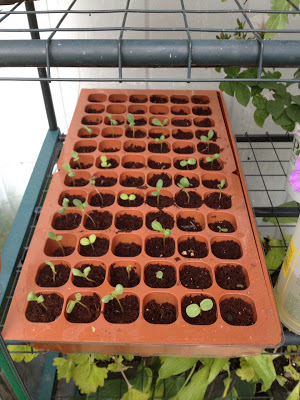 In this method, small cells are filled with seed-starting mix, and seeds —usually one or two—are sown into each cell.
In this method, small cells are filled with seed-starting mix, and seeds —usually one or two—are sown into each cell.
Pros: Relatively quick both up front and down the line. If more than one seed germinates per cell you will have to thin down to one seedling per cell later (just use a small scissors and chop off the weaker seedling at the soil level).
Cons: Prying the seedlings out of their cells when it’s time to pot them on (and you will have to do that with this method) can be a little challenging. It is also challenging to plant just few seeds of several varieties in this method because, for a time at least, they all share space in the same tray, under a humidity dome. With inexpensive (i.e. flimsy plastic) six-cell packs you can remove just the pack you need, but you’re still left with a minimum of six of a variety if you want to fill every hole.
The other con is that those flimsy plastic cell trays don’t last long so you may find yourself replacing them more frequently.
SOWING INTO SEED TRAYS

In this method you simply fill a seed tray (I really like these small seed trays that are durable, thick plastic) with seed-starting mix and sow seeds in the tray. After they have at least one set of true leaves, you carefully pull them out and put them into a cell tray or small pot.
Pros: Save on both seed-starting mix and space during the germination phase. This is also the quickest method, at least for the initial sowing. When you do put seedlings into individual cells, every cell will be filled, unlike starting directly in cells where spotty germination can leave you with wasted space.
Cons: It is very easy to sow too many seeds using this method, so try to limit yourself. And although it is speedier initially, you’ll spend extra time later pricking out seedlings. Some plants are less tolerant of root disturbance, so they wouldn’t be good candidates for this treatment.
My thoughts: I find myself using this method more often these days because the pros usually outweigh the cons for me.
[custom_code name=”amazon”]
STARTING IN SOIL BLOCKS
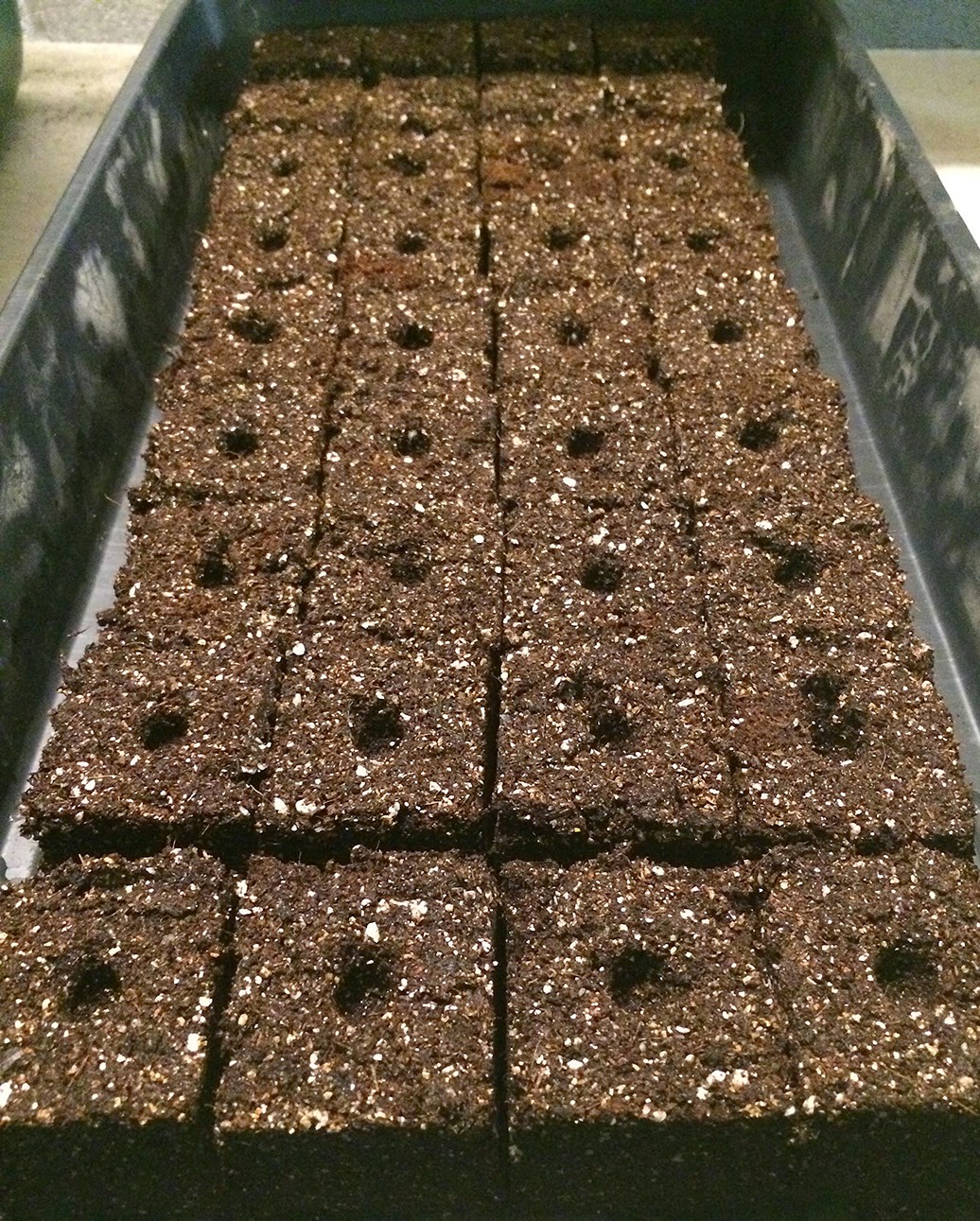
Using a soil blend (check mine out here, but there are other recipes and some pre-made mixes), and a soil blocker (a handy gadget that compresses soil into little blocks), you create pot-less pots. The soil blocker leaves a small divot in the top of each block (which I make in rows that are touching, like a cake that has been cut but no pieces removed) into which seeds are sowed. The smallest blocks will need to be transplanted quickly into larger blocks (an insert creates holes that are the perfect size). Larger blocks (1.75 to 2 inches square) will allow seedlings to grow on for quite some time.
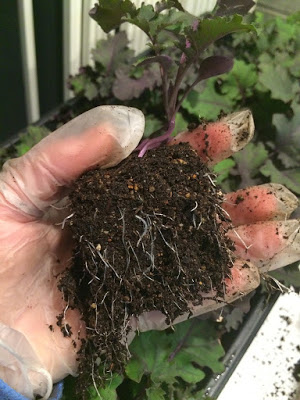
Pros: There are a lot of pros to growing in soil blocks. The first is that it leads to really healthy seedlings. Roots are air pruned, meaning they just stop at the edge, rather than circling around the bottom of a cell, a condition that can have a negative impact on long-term success. It also uses less plastic (but not no plastic as the blocks need to be put in a large solid-bottom tray).
The blocks are easy to pot on and for some seedlings will be able to be planted directly out in the garden with no root disturbance. They can be moved around in a tray to save room if some seeds don’t germinate.
Cons: Soil block soil either requires several ingredients or a purchasing a special premade mix. Either way it’s either time-consuming and messy or expensive. Blocks can dry out quickly as seedlings get large, requiring up to daily watering (bottom watering is required).
It can also take a little practice to get the soil-blocking method down. If the mix isn’t right the blocks will fall apart. Too dense and there isn’t a lot of room for roots to run free.
My thoughts: I used to grow exclusively from soil blocks and it worked really well. In the end, it was just so much time. I will probably use soil blocks in the future for anything that can be transplanted directly from the block to the garden. Things like kale and some flowers work will for this.
SOWING INTO INDIVIDUAL POTS
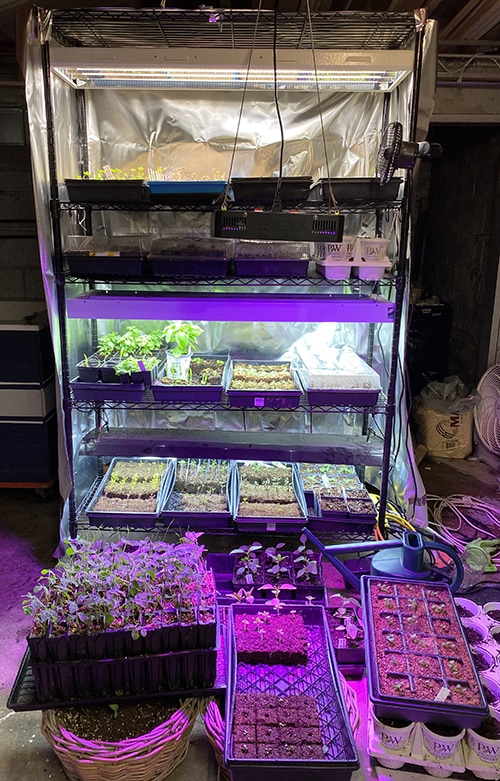
This method is only applicable to a small number of seeds that germinate and grow quickly. For anything else you’ll run into trouble with soil types and moisture management.
Pros: This is the right call for something like hyacinth beans, quick growing annual vines and possibly cucumbers or squash. You’ll want to use potting mix instead of seed-starting mix because those fast-growers will need more nutrients than seed-starting mix will give and since you won’t be potting these up, you only get one shot.
It’s a time saver because it’s a one-and-done operation.
Cons: Not appropriate for anything small or slow-growing. It also takes up a good amount of room if you’re planting more than a few seeds.
My thoughts: It’s the right call for a handful of things and I use it for those but that’s it.
USING A SEED STARTING SYSTEM
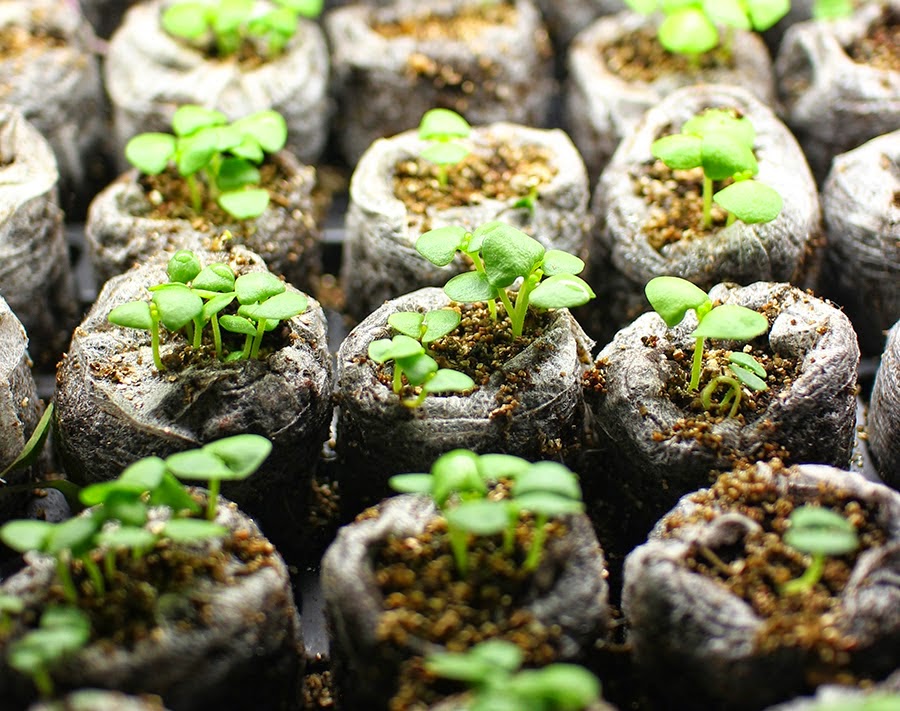 Seed-starting systems are all-in-one solutions for starting seeds, essentially including the tray, the cells (or pots), soil and humidity dome. These come in a variety of configurations, from the simple Jiffy set-ups to this very snazzy Bio Dome with a self-watering capillary mat.
Seed-starting systems are all-in-one solutions for starting seeds, essentially including the tray, the cells (or pots), soil and humidity dome. These come in a variety of configurations, from the simple Jiffy set-ups to this very snazzy Bio Dome with a self-watering capillary mat.
Pros: These are the ultimate in convenience and perfect for people who don’t start hundreds of seeds.
Cons: Some can be expensive and may need parts of the kit to be repurchased every year.
My thoughts: I haven’t tried a lot of these since I first used a Jiffy peat-pellet one decades ago. I think they seem like a great easy way to go for those new to seed starting or people who aren’t starting a lot of seeds.
DIRECT SOWING
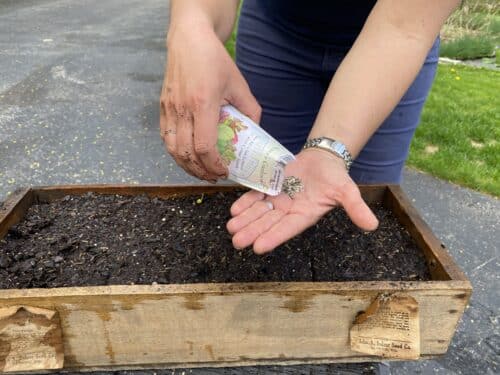
This is simple a matter of sowing seeds directly where they will ultimate grow in the garden.
Pros: There’s no plastic, no tending to seedlings, no extra equipment. Some seeds do better planted this way.
Cons: Direct sowing doesn’t mean no work. Soil needs to be prepared to a fine tilth. Timing is more important, and consistent moisture is required for germination, which may mean using a light covering over seeds or watering multiple times a day. Some seeds just won’t work this way, and others will have a tough time withstanding weather, wind and critters. And you’ll have to go back and thin seedlings later.
My thoughts: Although I try to direct sow as many things as I can because of the convenience of not having to babysit them inside, I also appreciate the ability to place seedlings myself. And in my packed borders, starting from seed there is typically not an option.
WINTER SOWING
Seeds are sown in mini greenhouses fashioned out of milk jugs, rotisserie chicken containers from the grocery store, even large zip-top bags. Anything that allows light through will work. These are put outside in winter where they just do their thing, naturally germinating and growing as temperatures rise. There’s an excellent article on it here but many other online resources.
Pros: Other than direct sowing, this is the most economical way of starting seeds. Containers are reused, and no lights, racks, fans or other equipment is necessary. It is wonderful for seeds that require a cold period as winter takes care of that for you, no need for refrigeration or other methods.
Cons: This method only works for some types of seeds, particularly cold-hardy annuals, perennials and some edibles. Although some people swear it works for warm-loving plants like tomatoes, it will certainly be a challenge.
My thoughts: I think this is a great way of starting seeds and if you don’t want to invest in seed-starting equipment I think it’s probably the best (better than relying a windowsill probably). But I do very little of it because I have terrible luck with it. I will try it with seeds that I want to grow, not things I need to grow, because I find it to be a bit iffy. Some people have wild success with it, so it’s definitely something that’s worth a try.
The method that’s best will vary from gardener to gardener, but odds are that some combination of a few different methods will be needed. None are better than another and a lot of it comes down to personal preference. So give a few a try and find what works for you.
A quick note on seed starting gear: If there was ever a place in gardening where you can get creative, seed starting is is. Think about what you can recycle. Plastic takeout or salad green boxes work great as mini seed trays with a humidity dome built in. If you have a whole bunch of plastic yogurt cups, red plastic cups or something similar sitting around, poke some holes in the bottom and use those for drainage.
If you think you’ll be growing plants from seeds for a the foreseeable future or you just crave organization, investing in some good supplies makes sense. These days I aim for higher quality trays with the aim to use them longer. The really cheap plastic trays are frustratingly flimsy and often only last one year.
Unless you’re planning to start all seeds by direct sowing or winter sowing, I highly recommend buying a grow light, even if it’s a cheap clip-on one meant for a single tray. It’s just too hard to grow seeds properly in a window, unless you have something close to conservatory-type light.
You can find all my gear setup here, but here’s a quick synopsis of some of my favorites:
- 4-foot grow light: This is my favorite light of all the ones I have. It’s an investment and, in my opinion, totally worth it.
- Humidity domes: These are just one step about the super flimsy ones, which are incredibly frustrating.
- Heavy duty solid trays: Buy these and buy them once. These are super heavy duty and should last forever.
- Giant garden tray: How did I live without these until this year? Well, by having a giant mess. I put all my trays in these and everything is so much cleaner.

4 Responses
Love your blog Erin!! And your dogs and your garden. And your ice cream drink! My new favorite❣️Let’s not forget Mr Patience!!
Thanks for sharing all your knowledge with us. I’m in zone 5b Iowa, and love it that you are too.
Happy gardening 🌸
Oh my! This is fantastic, exactly what I need to get started. We don’t deserve you, Erin.
I just read an article on starting/germinating seeds in an instant pot on the yogurt setting on attainable-sustainable website. And since my hubs built me a greenhouse I’ll have to try some of your seed potting methods too!